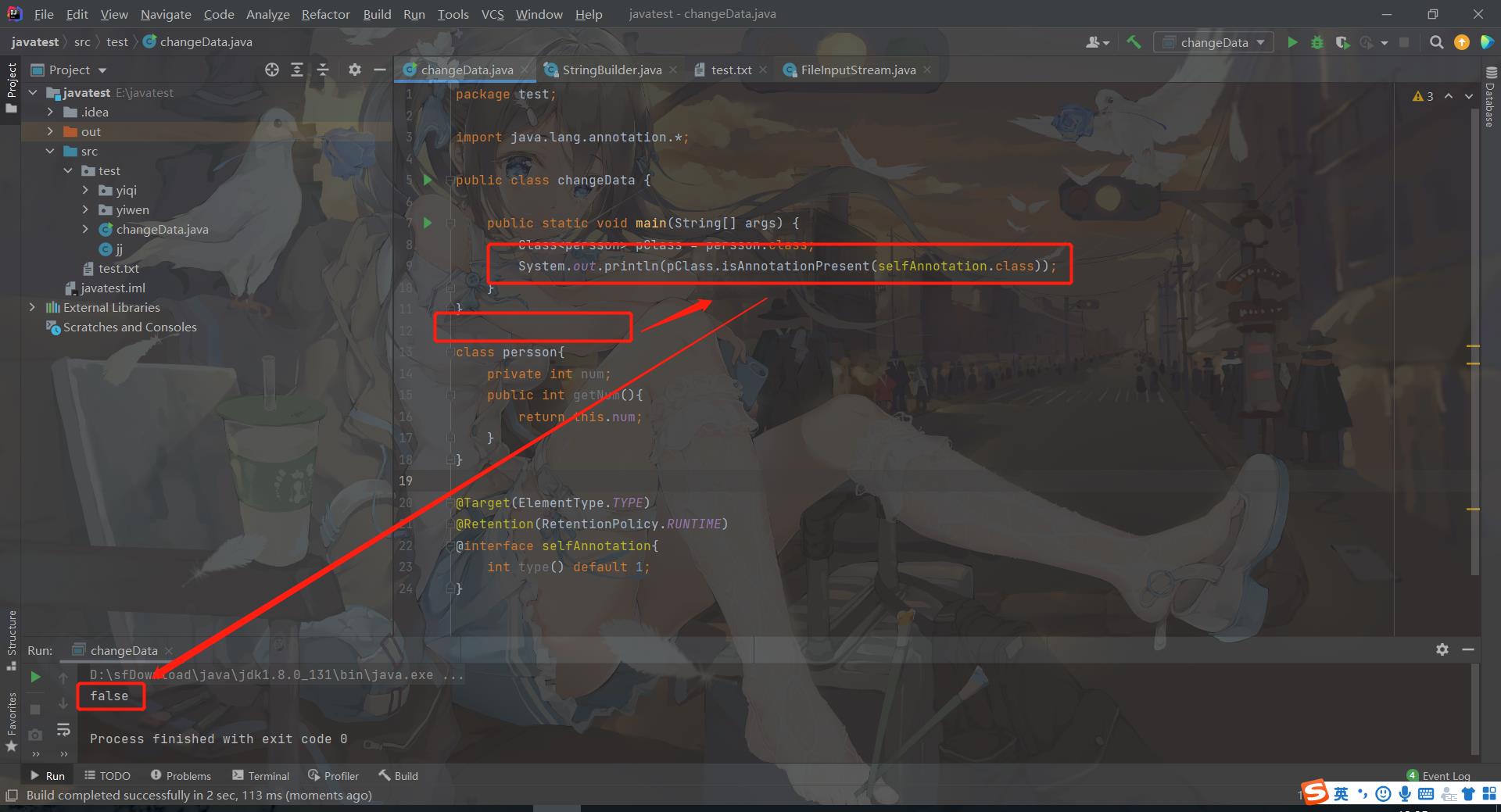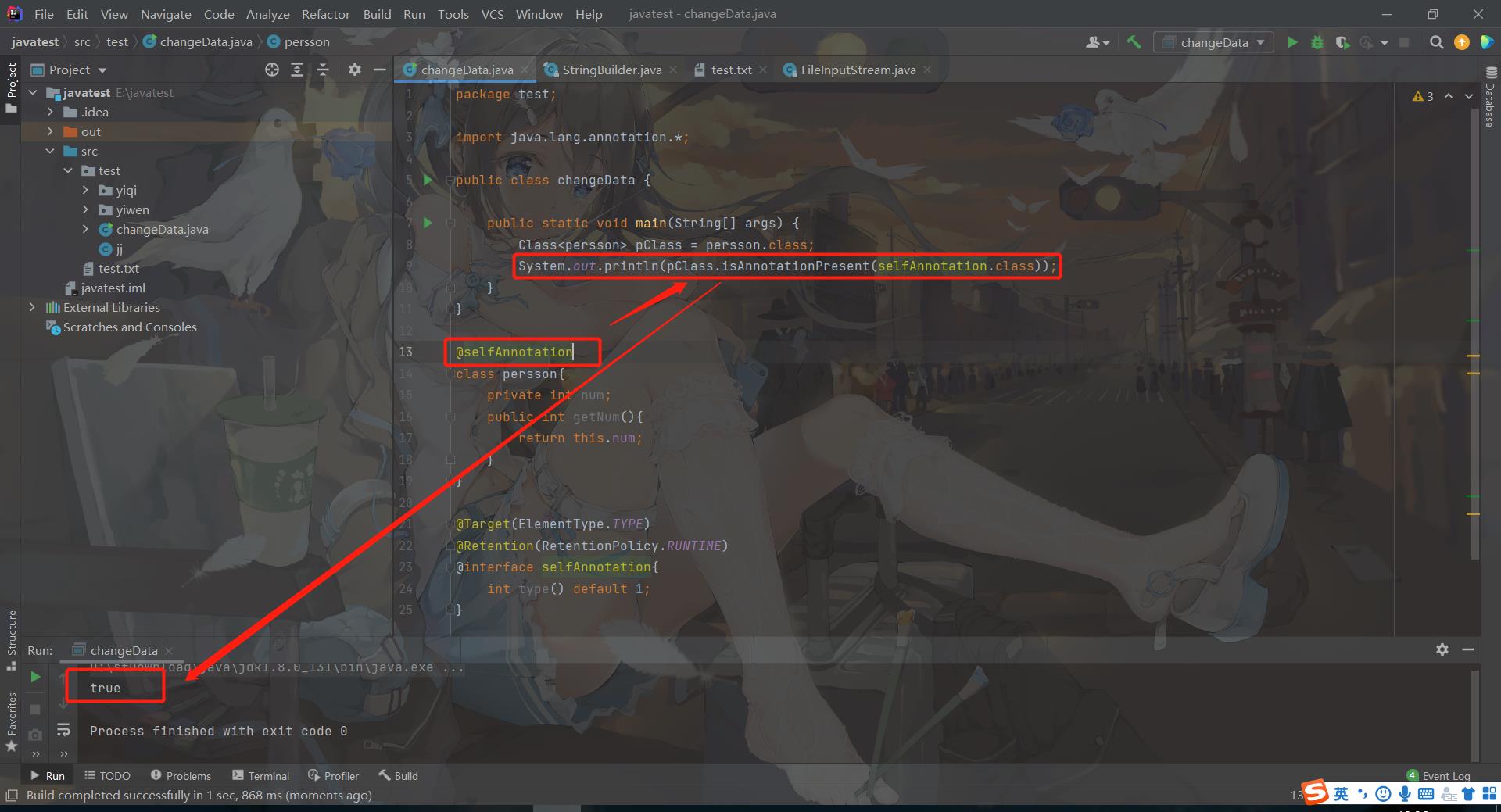java教程——注解
Posted 我想月薪过万
tags:
篇首语:本文由小常识网(cha138.com)小编为大家整理,主要介绍了java教程——注解相关的知识,希望对你有一定的参考价值。
知识背景
在 java教程——注解 这一节中我们提到过这么一句话:“这是Java代码读取该注解实现的功能,JVM并不会识别该注解“。所以,下面的内容就是教大家如何读取并识别自己写的注解。
我们都知道 注解是 分为三类的,根据运行时机(@Retention)可以分为:
SOURCE类型的注解在编译期就被丢掉了;CLASS类型的注解仅保存在class文件中,它们不会被加载进JVM;-
RUNTIME类型的注解会被加载进JVM,并且在运行期可以被程序读取。
我们反复强调:RUNTIME类型的注解不但要使用,还经常需要编写。因此,我们只讨论如何读取RUNTIME类型的注解。
因为注解定义后也是一种class,所有的注解都继承自java.lang.annotation.Annotation,因此,读取注解,需要使用反射API。
一、判断某个注解是否存在于
Class、Field、Method或Constructor:
Class.isAnnotationPresent(Class)
Field.isAnnotationPresent(Class)
Method.isAnnotationPresent(Class)
Constructor.isAnnotationPresent(Class)package test;
import java.lang.annotation.*;
public class changeData {
public static void main(String[] args) {
Class<persson> pClass = persson.class;
System.out.println(pClass.isAnnotationPresent(selfAnnotation.class));
}
}
@selfAnnotation
class persson{
private int num;
public int getNum(){
return this.num;
}
}
//第三步:添加元注解
@Target(ElementType.TYPE)
@Retention(RetentionPolicy.RUNTIME)
//第一步:定义注解
@interface selfAnnotation{
//第二步:定义参数
int type() default 1;
}


二、使用反射API读取Annotation:
Class.getAnnotation(Class)
Field.getAnnotation(Class)
Method.getAnnotation(Class)
Constructor.getAnnotation(Class)package test;
import java.lang.annotation.*;
public class changeData {
public static void main(String[] args) {
Class<persson> pClass = persson.class;
if(pClass.isAnnotationPresent(selfAnnotation.class)){
selfAnnotation annotation = pClass.getAnnotation(selfAnnotation.class);
System.out.println(annotation.type());
}
}
}
@selfAnnotation(type = 2)
class persson{
private int num;
public int getNum(){
return this.num;
}
}
//第三步:添加元注解
@Target(ElementType.TYPE)
@Retention(RetentionPolicy.RUNTIME)
//第一步:定义注解
@interface selfAnnotation{
//第二步:定义参数
int type() default 1;
}

三、读取方法参数的注解
我们都知道,一个函数的参数可以是多个,而一个参数的注解也可以是多个,所以,我们获取到的 参数的注解是一个二维数组,即第几个参数的第几个注解
package test;
import java.lang.annotation.*;
import java.lang.reflect.Method;
import java.util.Arrays;
public class changeData {
public static void main(String[] args) {
Class<persson> pClass = persson.class;
try {
Method method_getNum = pClass.getMethod("getNum", int.class);
Annotation[][] parameterAnnotations = method_getNum.getParameterAnnotations();
System.out.println(Arrays.toString(parameterAnnotations[0]));
} catch (NoSuchMethodException e) {
e.printStackTrace();
}
}
}
class persson{
private int num;
public int getNum(@two @one int a){
return this.num;
}
}
@Retention(RetentionPolicy.RUNTIME)
@Target(ElementType.PARAMETER)
@interface one{
int type() default 1;
}
@Retention(RetentionPolicy.RUNTIME)
@Target(ElementType.PARAMETER)
@interface two{
int value() default 2;
}

四、使用注解
注解如何使用,完全由程序自己决定。例如,JUnit是一个测试框架,它会自动运行所有标记为@Test的方法。
我们来看一个@Range注解,我们希望用它来定义一个String字段的规则:字段长度满足@Range的参数定义:
@Retention(RetentionPolicy.RUNTIME)
@Target(ElementType.FIELD)
public @interface Range {
int min() default 0;
int max() default 255;
}
在某个JavaBean中,我们可以使用该注解:
public class Person {
@Range(min=1, max=20)
public String name;
@Range(max=10)
public String city;
}
但是,定义了注解,本身对程序逻辑没有任何影响。我们必须自己编写代码来使用注解。这里,我们编写一个Person实例的检查方法,它可以检查Person实例的String字段长度是否满足@Range的定义:
void check(Person person) throws IllegalArgumentException, ReflectiveOperationException {
// 遍历所有Field:
for (Field field : person.getClass().getFields()) {
// 获取Field定义的@Range:
Range range = field.getAnnotation(Range.class);
// 如果@Range存在:
if (range != null) {
// 获取Field的值:
Object value = field.get(person);
// 如果值是String:
if (value instanceof String) {
String s = (String) value;
// 判断值是否满足@Range的min/max:
if (s.length() < range.min() || s.length() > range.max()) {
throw new IllegalArgumentException("Invalid field: " + field.getName());
}
}
}
}
}
这样一来,我们通过@Range注解,配合check()方法,就可以完成Person实例的检查。注意检查逻辑完全是我们自己编写的,JVM不会自动给注解添加任何额外的逻辑。
这里面还涉及到了反射的知识点,大家可以查看这几篇文章 java教程——反射(一)
以上是关于java教程——注解的主要内容,如果未能解决你的问题,请参考以下文章